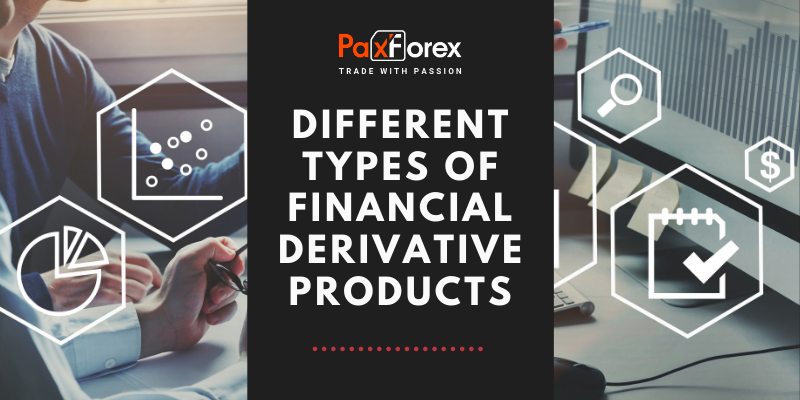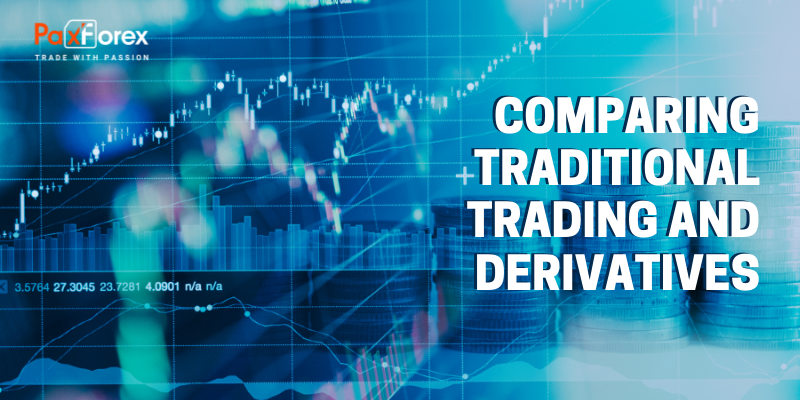
When we talk about trading, our minds automatically think of currencies, stocks, or, in some cases, bonds and funds. But the selection of available trading instruments stretches far beyond that. Today, we get familiar with an asset category that offers just as many opportunities and potential as the most popular trading devices. More specifically, we will discuss what is a financial derivative, and what do you need to know about it to trade successfully.
What is a Financial Derivative
The best way to describe what is financial derivatives is securities, the value of which is derived, hence the name, from an underlying asset or assets. The derivative financial significance translates into a contract between two or more parties, and its price directly depends on the prices of the assets within.
While the derivatives financial are trading tools on their own, the assets they represent can also participate in the trading process. For example, the underlying assets of a financial derivative can include currencies, stock indices, bonds, commodities (such as gold or silver), and, in the most recent years — cryptocurrencies.
There are, of course, certain specifics of dealing with financial derivatives, and it would be fair to say from the beginning that they are a rather advanced instrument class. However, anything is possible for a trader who strives to explore as many alternatives as possible. So, let’s continue to discuss what is financial derivative, starting with the reasons to include them in your portfolio.
Benefits of Financial Derivatives
Unlike the more traditional approaches to trading that exist primarily for the purpose of generating profit, derivatives financial intentions are slightly different. More often than not, traders have a larger-picture agenda in mind when including derivatives into their trading arsenals.
There are three general paths that involve derivative financial trading. They are: leveraging, hedging, and speculating on the future potential value of the underlying asset. Below we are going to take a closer look at each of these categories to get a better understanding.
- Leverage
What is financial derivatives most popular application across the markets? Leverage. In case you are not familiar with the concept, leverage is a highly useful tool for traders who want to increase the potential outcome of their positions. Outside of what is financial derivative, leveraging usually takes a form of a loan from a broker, which allows a trader to perform on enhanced levels.
While leverage is extremely helpful, it has to be used with discretion. Because as the potential profit magnifies, so does the level of risk-taking. That’s why it is always a good idea to polish off your trading skills and knowledge before leveraging your positions. But as soon as you feel comfortable with your capabilities, using leverage should be a piece of cake.
- Hedging
While leveraging your positions focuses on increasing the potential profit, hedging exists to take control of the potential risks. The most straightforward explanation of hedging is simultaneously opening a long and short position using the same pair.
In theory, this sounds illogical, since the opposite positions essentially cancel each other out. However, in practice, the trader will close one of the positions as soon as the market’s movement is apparent. This approach is clearly effective, but most brokers either do not allow it altogether or have a set of specific requirements to follow. Consult with your broker to find out whether hedging is an option for you, and if not, discover other ways to protect your positions.
- Speculation
Finally, the essence of online trading is the basic act of price speculation. The whole idea is to profit off value fluctuations by buying assets at their low and selling at their high. But what is a financial derivative advantage over traditional trading instruments when it comes to speculation?
Derivatives, unlike the actual assets, allow the traders to profit from both the price increase (that basic buy-low-sell-high model) and the price drops. The real point of interest isn’t the significance of the value, but the range of difference between the starting point and the exit. This way, derivative financial is practically a foolproof approach. But, of course, there is still a lot to learn before you can successfully start trading derivatives financial.
Different Types of Financial Derivative Products

Now that you have a general understanding os what is a financial derivative, it’s time to get more specific and discuss the exact products that categorize as derivatives. Technically, the market of derivatives financial solutions is very versatile. But, it’s important to mention that the largest portion of this versatility comprises customized over-the-counter (OTC) derivatives, such as contracts for difference (CFDs).
OTC derivative financial instruments usually come along with a solid deal of risks. Since the contract is between two parties, each participant has an equal rate of risk exposure. For instance, if one of the sides experiences bankruptcy, the contract will not be fulfilled.
To partially reduce such risks, derivatives traded on online exchange platforms undergo very strict regulations. As a result, the initial investment amount tends to stay on a higher side, making derivatives less approachable to small and mid-size investors.
You know from the above that there are limitless approaches to what is financial derivatives trading. However, there are four distinguishable main types: CFDs, futures, forward contracts, and options. In the next segment, we will briefly discuss the specifications of each of these instruments.
- CFDs
Contract for difference, or CFD for short, is the most commonly known form of what is financial derivatives. Essentially, CFD is an arrangement between the buyer and the seller (typically a broker) that ensures the cash compensation of the difference between the opening and closing prices. This means that there is no physical delivery of the assets.
Contract of difference is a popular tool across most markets, including currencies and cryptocurrencies, stocks, commodities, and many others. The biggest advantage of trading CFDs is access to all the benefits of actual investing, without the necessity to own a physical asset. In the case of commodities, for example, the exclusion of physical ownership can be a significant asset, as it eliminates the costs for storage and transportation, as well as cancels out the risks associated with the expiration limitations of the product (for instance, sunflower oil or coffee beans).
- Futures
Future contracts, or simply ‘futures,’ are a form of what is financial derivatives that focuses on the agreement between the buyer and the seller to exchange an asset at the specific rate and time. Such agreements were initially designed to minimize the risks associated with price volatility and were primarily interesting for raw material producers, such as farmers.
The original idea was to ensure you will sell your product, let’s say corn, at the beneficial price when the crop is ripe, disregarding how much it costs by that moment. However, it’s pretty clear from the concept that even those traders who weren’t excited with the idea of buying corn found that approach profitable, and it spread across other markets, including Forex.
Although the average future contract time traditionally ranges between three to five months, the majority of currently active futures get executed within one day by the speculators who aim to resell the contract and gain profit.
An investor can only purchase futures on regulated exchanges after agreeing to a standard set of terms and conditions. And since the futures are transferable, every trader that participates in the process of speculation is subjected to the terms of the contract.
- Forward contracts
Forward contracts share the same concept with futures: an agreement to exchange assets at the specified rate and time. However, unlike the futures contracts, the forwards do not undergo any sort of regulation and can be customized to unlimited extends. This, in turn, means that there is no exact way to measure the forward contract market, as the majority of transactions take place off the common exchanges and over the counter.
Another difference between futures and forwards is the fact that a future contact is transferrable and can be executed at any point, while the forward contract is executed at the point of its maturity.
- Options
Options, as you might have guessed from the name, is not an obligation, but a possibility yo buy or sell an asset at the specified date and price. Purchasing an option is a highly popular approach to risk management and profit optimization. By having an opportunity to process a transaction at a comfortable rate, a trader can calmly observe the direction the market takes and make a decision accordingly.
Of course, in order to benefit from an option, the investor will have to pay a certain fee that serves as the collateral for the contract in case the buyer doesn’t execute it. This means that while the risk of the option owner is limited to the initial payment, known as the premium fee, the seller is facing higher risks as they will be obligated to fulfill the contract regardless.
Some of the terms of options trading include call option (grants the right to buy), put option (to sell), in the money (when the option is profitable), and out of money or under-water (for when the option brings losses).
At this point, you have more than a good idea of what is a financial derivative. Next, let’s take a few minutes discussing the major differences between trading derivatives financial and traditional instruments.
Comparing Traditional Trading and Derivatives

Basically, the derivative financial trading is a solution to taking advantage of traditional assets without having to own them. Some other benefits include the ability to earn profit from the price fluctuations in any direction, rather than just up, maximizing your gain by using leverage, and having access to a versatile set of tools.
On the other hand, while not owning a physical asset is highly convenient from a speculating perspective, it has its downside. For instance, when you trade stock CFDs, you are not entitled to having a decision-making privilege on the company’s board, as well as you won’t receive any dividends other than the profit from the price fluctuations. This means that you will still benefit from the success of the company, but not as much as the physical shareholders.
Another point to consider is that the large portion of what is financial derivatives on the modern trading scene is wildly unregulated. Consequently, a lot of brokers exist with the sole purpose of fraud. That’s why traders, especially the inexperienced ones, have to be extra careful when choosing a broker to trade with.
On top of that, each broker has different rules and conditions regarding every particular instrument. In some cases, access to derivative financial trading can be very limited or entirely unavailable. So before you dive into exploring the market and getting used to its specifics, make sure the broker you go with will be able to meet all of your requirements.
Final Thoughts on Financial Derivatives
The shortest answer to what is a financial derivative is — a trading tool. And just like any other tool out there, financial derivatives require an attentive and thoughtful approach. Once you set your eyes on one of the derivative instruments, take your time and find out as much as possible, considering both the complexity of the trading process and your personal knowledge, resources, and capabilities. Any trading instrument can turn into an ultimate weapon, as long as you learn to use it right.







